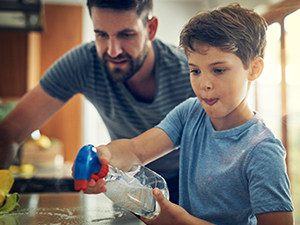April 20, 2022
 New facts are continually becoming available regarding COVID-19. Consequently, this article will eventually become outdated. For the most up-to-date information, please refer to the Centers for Disease Control Centers for Disease Control and the Environmental Protection Agency.
New facts are continually becoming available regarding COVID-19. Consequently, this article will eventually become outdated. For the most up-to-date information, please refer to the Centers for Disease Control Centers for Disease Control and the Environmental Protection Agency.The Coronavirus and Your Stone Countertops
The entire world is in a panic over the new coronavirus, and as a stone expert, my phone is ringing off the hook with questions. Can the coronavirus survive on my stone countertop? If so, for how long? What do I use on my stone to properly kill the virus?How long can the coronavirus survive on stone surfaces?
The short answer is, we don't know. However similar viruses, such as SARS and MERS, can survive for up to 9 days. The common flu virus can last up to 48 hours on a stone surface. Additional studies have shown that the virus can last for over a week but seems to have a shorter lifespan at temperatures over 86 degrees F. Of course, stone surfaces would rarely reach those high temperatures in an average kitchen environment.Can you get the coronavirus by touching a contaminated stone countertop?
Again, there is not enough information or studies that confirm that the coronavirus acts similar to other viruses. However, some studies are showing that the virus can be killed with standard household disinfectants. One study showed that disinfectants with 62-71% ethanol, 0.5% hydrogen peroxide or 0.1% sodium hypochlorite (bleach) can inactivate the coronavirus within a minute. Although the study shows that the coronavirus is similar to SARS, it is not yet clear if the coronavirus will act the same as SARS. So, can you get the virus by touching a contaminated stone surface? According to the Centers for Disease Control and Prevention (CDC), touching a surface is not believed to be the main way the virus is transferred. The most likely way it is spread is from person to person from coughs and sneezing.How do you properly disinfect your stone surface to kill the coronavirus?
Currently, it is believed that most household disinfectants can kill the virus. However, I have discovered that many people do not know how to properly use these sanitizing solutions. Many people will spray and immediately wipe a disinfectant. This method will not kill the virus. The disinfectant should be allowed to dwell on the countertop for 3-5 minutes to be effective. You can also make your own disinfectant by mixing one half rubbing alcohol with one half water. Spray the disinfectant on the countertop and thoroughly wet the surface. Allow the solution to sit for 3-5 minutes. Rinse with clean water and then dry with a microfiber cloth.The best advice is to keep your stone countertop clean by following these simple steps.
To keep your granite in tip-top condition, a few simple maintenance procedures are necessary. For best results, they should be followed very closely.According to the World Health Organization (WHO), the best way to avoid the coronavirus is to:
A Final Word
As the coronavirus spreads, there is sure to be misinformation on how it spreads. The best way to know the truth is to keep an eye on the CDC and WHO websites, as well as your local health department.References
